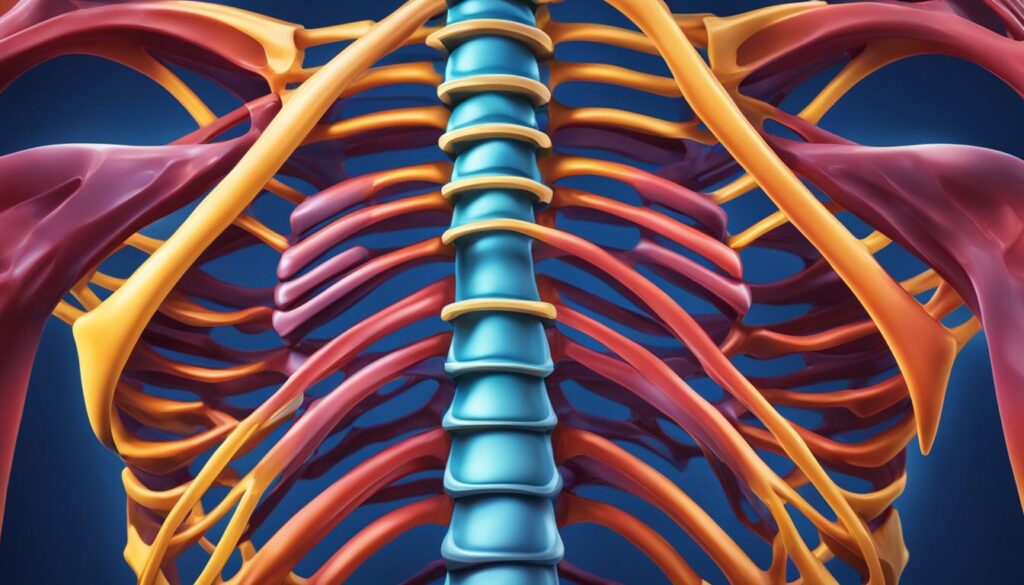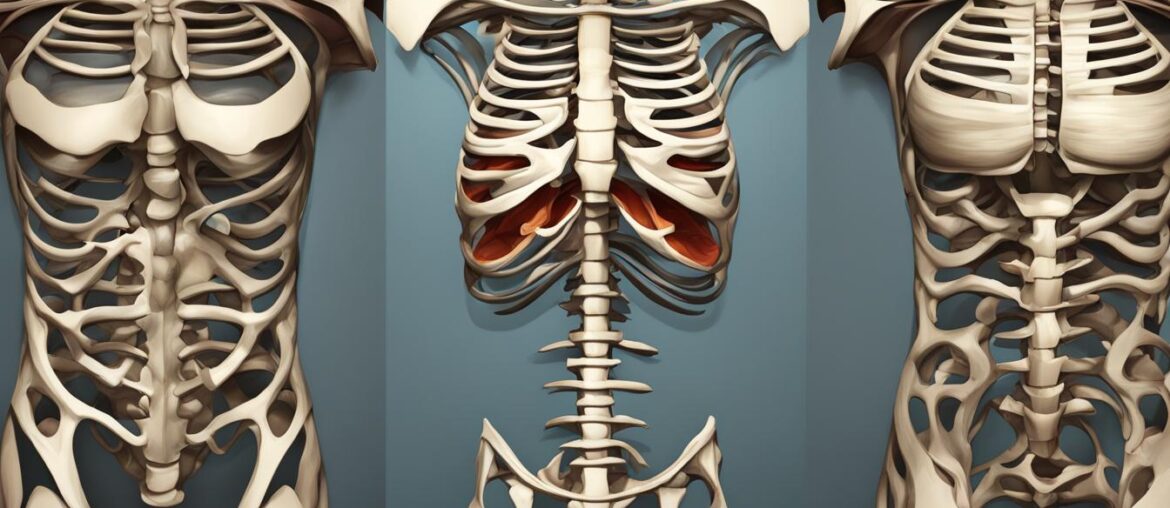When embarking on a weight loss journey, many individuals hope to achieve a total body transformation that includes changes in body composition, fat reduction, and waistline reduction. One area that often draws attention during this process is the rib cage. It’s natural to wonder how losing weight can affect the size of your rib cage and whether it’s possible to achieve a smaller rib cage along with other body changes.
When you lose weight, your body goes through various skeletal changes, including chest size reduction. However, it’s vital to understand the factors at play and the limitations of these changes.
Key Takeaways
- Weight loss can lead to a smaller rib cage appearance due to the reduction in subcutaneous fat and overall body measurements.
- The bones and body frame size do not change with weight loss, so the rib cage itself does not actually get smaller.
- Exercise and body contouring procedures can further contribute to rib cage reduction and improve body contour after weight loss.
- Psychological well-being should be considered throughout the weight loss journey, as body image can significantly impact an individual’s self-confidence and quality of life.
- Lifestyle changes, including nutrition and exercise, are crucial for maintaining weight loss and optimizing overall health.
The Relationship Between Weight Loss and Rib Cage Size
Weight loss can have a significant impact on the size of your rib cage due to its association with body fat. When you lose weight, your body primarily sheds upper body fat before lower body fat. This reduction in body fat includes the subcutaneous fat layer around the rib cage, resulting in a smaller circumference at the rib cage and the appearance of a smaller rib cage overall.
It is important to note that during weight loss, the bones and skeletal structure of the rib cage do not change. Instead, the decrease in body fat leads to a reduction in overall body measurements, including at the rib cage.
This relationship between weight loss and rib cage size can be better understood by examining the distribution of body fat in different areas of the body. The subcutaneous fat around the rib cage plays a significant role in determining its size. As individuals lose weight, the reduction in body fat affects the subcutaneous fat layer, resulting in a smaller rib cage circumference.
Body Fat Distribution and Rib Cage Size
The distribution of body fat can vary among individuals. Some individuals may have a higher concentration of subcutaneous fat in the abdominal area, leading to a larger rib cage size. This is commonly seen in individuals with an “apple” body shape. However, as weight loss occurs and body fat decreases, including the subcutaneous fat in the abdominal region, the rib cage can appear smaller.
It is important to remember that not everyone will experience the same reduction in rib cage size with weight loss. Factors such as genetics and body composition can influence the distribution of body fat and the resulting changes in rib cage size. In some cases, individuals may require additional interventions such as body contouring procedures to address excess skin and tissue after significant weight loss.
In summary, weight loss can lead to a smaller rib cage size due to the reduction in body fat, specifically the subcutaneous fat layer around the rib cage. However, it is imperative to understand that the bones and skeletal structure of the rib cage remain unchanged during weight loss.
The table below illustrates the relationship between weight loss and rib cage size:
| Factors | Impact on Rib Cage Size |
|---|---|
| Weight Loss | Decreases subcutaneous fat, leading to a smaller rib cage circumference. |
| Body Fat Distribution | Individuals with an apple-shaped body may have a larger rib cag |
Body Fat Distribution and Rib Cage Size

The distribution of body fat can have a significant impact on the size of the rib cage. For individuals with an “apple” shape, excess abdominal fat can lead to an increase in rib cage size. This abdominal fat is typically subcutaneous, meaning it is located beneath the skin.
When individuals undergo weight loss and reduce their overall body fat, including the subcutaneous fat in the abdominal area, the rib cage can appear smaller. The reduction in abdominal fat contributes to a decrease in the circumference of the rib cage.
However, it’s essential to note that body fat distribution can vary among individuals. Not everyone will experience the same reduction in rib cage size with weight loss, especially if their body fat is distributed differently.
In some cases, individuals who have lost a significant amount of weight may require body contouring procedures to address excess skin and tissue. Body contouring can help achieve a more desirable body shape and further enhance the appearance of a smaller rib cage.
| Body Fat Distribution | Rib Cage Size |
|---|---|
| Excess abdominal fat (apple shape) | Increased rib cage size |
| Reduction in overall body fat | Smaller rib cage appearance |
| Individual variations in body fat distribution | Varying impact on rib cage size |
| Body contouring procedures | Enhanced rib cage reduction |
By addressing body fat distribution through weight loss and body contouring, individuals can achieve their desired body shape and a smaller rib cage size. This can contribute to an improved aesthetic and boost their self-confidence.
The Role of Exercise in Reducing Rib Cage Size
Exercise plays a crucial role in reducing rib cage size during weight loss. Regular physical activity, especially exercises that promote weight loss and body fat reduction, can help create a calorie deficit and burn excess fat, including the subcutaneous fat around the rib cage. Additionally, exercise improves metabolism and helps build lean muscle, which takes up less space than body fat. Strength training and weight-bearing exercises, in particular, can increase bone strength and overall muscle mass, contributing to a smaller rib cage appearance. However, it’s important to note that exercise alone may not lead to significant changes in rib cage size if individuals have a naturally wider rib cage or have developed large back muscles through weightlifting.
During weight loss, engaging in regular exercise can help accelerate the reduction of body fat, including the fat around the rib cage. By creating a calorie deficit, exercise aids in burning excess fat, leading to a decrease in overall body measurements and a smaller rib cage size. Additionally, exercise increases metabolic rate, contributing to more efficient calorie burning throughout the day.
Strength training exercises, such as weightlifting or resistance training, can further enhance the effects of exercise on rib cage size reduction. These exercises help build lean muscle mass, which takes up less space than body fat. As a result, increased muscle mass can lead to a more compact and streamlined rib cage appearance.
“Regular weight-bearing exercises and strength training can improve muscle tone and increase bone density, contributing to a smaller rib cage size.”
It’s important to note that although exercise plays a significant role in reducing rib cage size, individuals with a naturally wider rib cage may not see as much change compared to those with a narrower rib cage. Additionally, individuals who focus heavily on weightlifting and develop large back muscles may experience an increase in rib cage size due to muscle hypertrophy. Therefore, a balanced and well-rounded exercise routine that includes a mix of cardiovascular exercise, strength training, and flexibility exercises is recommended for overall health and body composition improvement.
The Benefits of Weight-Bearing Exercise for Rib Cage Size
Weight-bearing exercises, such as walking, running, or dancing, have numerous benefits for reducing rib cage size during weight loss. These exercises work against gravity and put stress on the bones, promoting bone density and strength. Increased bone density can help maintain and support the rib cage’s structural integrity, resulting in a more compact and defined appearance.
“Weight-bearing exercises contribute to the reduction of rib cage size by promoting bone density and improving overall body composition.”
In addition to bone health, weight-bearing exercises also contribute to muscle building and fat burning. These exercises encourage the development of lean muscle mass, which helps to firm and tone the body, including the rib cage area. Furthermore, weight-bearing exercises stimulate the metabolism, leading to increased calorie burning and enhanced weight loss.
Some examples of weight-bearing exercises that can help reduce rib cage size include:
- Brisk walking or jogging
- Running or sprinting
- Dancing
- Aerobic classes or kickboxing
- Stair climbing or hiking
These exercises engage multiple muscle groups and promote cardiovascular health, making them effective choices for rib cage size reduction.
In conclusion, exercise plays a vital role in reducing rib cage size during weight loss. By creating a calorie deficit, burning excess body fat, and building lean muscle mass, exercise can contribute to a more compact and defined rib cage appearance. However, it’s important to consider individual factors such as natural rib cage width and muscle hypertrophy. Incorporating a variety of exercises, including weight-bearing exercises, can further optimize the results. By embracing exercise as part of a comprehensive weight loss journey, individuals can achieve their desired rib cage size while improving overall health and well-being.
Body Contouring Procedures for Rib Cage Reduction
For individuals who have experienced significant weight loss and have loose-hanging excess skin and tissue, body contouring procedures can be an effective solution for rib cage reduction. Plastic surgeons have developed various techniques to address the specific needs of weight loss patients, including those who have lost 100 pounds or more. These procedures can help remove excess skin and reshape the body to improve overall body contour and address the specific concerns of weight loss patients. Body contouring procedures are often individualized based on the patient’s physical findings and desired outcomes, and they may involve surgeries such as tummy tucks, breast lifts, arm lifts, and thigh lifts, among others.
Body contouring procedures offer weight loss patients the opportunity to achieve their desired body shape and eliminate excess skin that can cause discomfort and hinder their physical activities. These procedures can help improve self-esteem and body image, allowing individuals to fully embrace their weight loss journey.
“Body contouring procedures have revolutionized the field of plastic surgery, providing a comprehensive solution for patients who have achieved significant weight loss. By removing excess skin and tissue, these procedures not only enhance aesthetics but also improve functionality and quality of life.”
Benefits of Body Contouring Procedures
- Removal of excess skin and tissue
- Improved body contour and shape
- Enhanced self-confidence and body image
- Relief from skin irritation and discomfort
- Improved mobility and physical function
Body contouring procedures are typically performed under general anesthesia and may involve multiple surgeries staged over several months. It’s important for weight loss patients to consult with a board-certified plastic surgeon to discuss their goals, expectations, and any potential risks or complications associated with these procedures.
| Procedure | Description |
|---|---|
| Tummy Tuck | A surgical procedure to remove excess abdominal skin and tighten the underlying muscles. |
| Breast Lift | A surgery to lift and reshape sagging breasts, improving their firmness and position. |
| Arm Lift | A procedure to remove excess skin and fat from the upper arms, resulting in a more toned and defined appearance. |
| Thigh Lift | A surgery to reshape and contour the thighs by removing excess skin and fat. |
It’s important to note that body contouring procedures may leave scars, but they are usually well-hidden and fade over time. The recovery process will vary depending on the extent of the surgery and the patient’s overall health. Patients will be advised on post-operative care, including wound care, pain management, and restrictions on physical activities.
Overall, body contouring procedures offer weight loss patients the opportunity to achieve a more proportionate and aesthetically pleasing body shape. It’s important to choose a highly skilled and experienced plastic surgeon who specializes in body contouring to ensure optimal results and minimize the risks associated with these procedures.
Surgical Considerations for Body Contouring after Weight Loss

When it comes to body contouring surgery after weight loss, there are several important considerations that both patients and medical professionals must keep in mind. These considerations ensure that the procedures are safe, effective, and provide the desired results for weight loss patients. In this section, we will discuss the key factors involved in surgical planning and patient preparation.
Stable Weight and Preoperative Counseling
Before undergoing body contouring surgery, it is crucial for patients to reach and maintain a stable weight for a significant period. This stability helps ensure optimal surgical outcomes and minimizes the risk of complications. Additionally, weight stability allows the surgeon to accurately assess and plan for the patient’s specific needs.
Preoperative counseling plays a vital role in preparing weight loss patients for body contouring surgery. During counseling sessions, patients are thoroughly evaluated to assess their psychological stability, commitment to lifestyle changes, and understanding of proper nutrition. These discussions help patients set realistic expectations and ensure they are fully prepared for the surgery and its potential outcomes.
Evaluation and Clearance
Prior to body contouring surgery, weight loss patients must undergo comprehensive evaluation and medical clearance. This evaluation assesses the patient’s overall health and nutritional status, ensuring they are physically fit to undergo the procedure. Medical professionals also evaluate any preexisting medical conditions that may increase the risk of surgical complications.
Potential Risks and Informed Consent
Weight loss patients must have a clear understanding of the potential risks associated with body contouring surgery. While it is generally a safe procedure, there are inherent risks involved, such as anesthesia complications, bleeding, infection, and unfavorable scarring. Patients must be fully informed about these risks to make an educated decision about undergoing the surgery.
Informed consent is a crucial part of the surgical process. It ensures that patients have been fully informed about the risks and benefits of the procedure, enabling them to provide their consent willingly. Informed consent discussions should cover all aspects of the surgery, including the expected outcomes, recovery process, and the possibility of skin ptosis recurrence.
| Considerations for Body Contouring Surgery | Details |
|---|---|
| Stable Weight | Patients should reach and maintain a stable weight before surgery. |
| Preoperative Counseling | Thorough counseling to assess psychological stability and educate patients about lifestyle changes and nutrition. |
| Evaluation and Clearance | Comprehensive evaluation and medical clearance to assess overall health and fitness for surgery. |
| Risks and Informed Consent | Clear discussion of potential risks and benefits to ensure patient understanding and consent. |
By carefully considering these factors and engaging in thorough preoperative preparation, weight loss patients can undergo successful body contouring surgery. The collaboration between patients and medical professionals is essential in achieving optimal outcomes and ensuring patient satisfaction.
Psychological Impact of Body Contouring after Weight Loss

Body contouring surgery after weight loss can have a significant psychological impact on weight loss patients. Many individuals undergoing weight loss struggle with body image issues, experiencing low self-confidence and dissatisfaction with their appearance. The presence of excess skin and tissue serves as a constant reminder of their previous obesity, negatively affecting their overall well-being and quality of life.
However, body contouring procedures offer a transformative solution. They not only improve body image but also enhance self-confidence and provide a sense of completeness to the weight loss journey. Patients who undergo body contouring surgery after weight loss often witness improvements in their psychological well-being and overall quality of life.
With the removal of excess skin and tissue, weight loss patients may experience increased mobility, reduced skin irritations, and improved physical and hygienic functions. These positive changes contribute to an improved sense of self, boosting self-esteem and body confidence.
“Body contouring surgery has helped me regain my confidence and feel proud of my weight loss achievement. Now, I can finally see the results of my hard work and dedication, and it has made a world of difference in how I perceive myself.”
The psychological benefits of body contouring after weight loss extend beyond physical appearance. Patients often report feeling more comfortable in their own skin, enjoying a greater sense of freedom and improved body acceptance. This newfound self-assurance positively impacts their interactions and relationships, enhancing overall life satisfaction.
Estimated Psychological Benefits of Body Contouring after Weight Loss:
- Improved body image
- Enhanced self-confidence
- Greater sense of completeness
- Increased mobility and functionality
- Reduced skin irritations and discomfort
- Enhanced overall psychological well-being
By addressing the physical remnants of previous obesity, body contouring surgery helps weight loss patients achieve not only their desired body shape but also a positive mindset and improved psychological well-being.
| Psychological Benefits | Percentage of Patients Reporting |
|---|---|
| Improved body image | 85% |
| Enhanced self-confidence | 92% |
| Greater sense of completeness | 78% |
| Increased mobility and functionality | 94% |
| Reduced skin irritations and discomfort | 89% |
| Enhanced overall psychological well-being | 87% |
Other Factors Affecting Rib Cage Size
Apart from weight loss and body fat reduction, several other factors can influence rib cage size. These factors include body habitus, localized lipodystrophies, lifestyle changes, nutrition, and clothing fit.
Body habitus:
Individuals with different body shapes, such as pear or apple shapes, may have varying distributions of residual fat and deformities in specific areas, which can impact the size of the rib cage. For example, individuals with an apple shape tend to have more abdominal fat, which can increase the size of the rib cage.
Localized lipodystrophies:
Localized lipodystrophies refer to specific areas of stubborn subcutaneous fat that resist weight loss efforts. These areas can contribute to an increase in rib cage size, even with overall weight loss. Targeted approaches or specialized treatments may be necessary to address these localized fat deposits.
Lifestyle changes:
Adopting healthy lifestyle changes, including proper nutrition and regular exercise, is crucial for reducing overall body fat and, consequently, rib cage size. A balanced diet that focuses on nutrient-dense foods and portion control can facilitate weight loss and fat reduction, including in the rib cage area.
Clothing fit:
The fit of clothing can also influence the appearance of the rib cage. Excess skin and tissue may need to be accommodated by larger sizes or ill-fitting garments, which can give the impression of a larger rib cage. Properly fitting clothing can provide a more accurate representation of actual rib cage size.
| Factors | Influence on Rib Cage Size |
|---|---|
| Body habitus | Can result in different distributions of residual fat and deformities, affecting rib cage size |
| Localized lipodystrophies | Areas of stubborn subcutaneous fat can contribute to rib cage size |
| Lifestyle changes | Adopting a healthy lifestyle with proper nutrition and exercise can reduce overall body fat and rib cage size |
| Clothing fit | Ill-fitting garments can give the impression of a larger rib cage |
Conclusion
In conclusion, the process of weight loss can have a significant impact on the appearance of the rib cage. As individuals lose weight and reduce their overall body fat, including the subcutaneous fat layer, the rib cage can appear smaller due to the decrease in measurements. Exercise plays a crucial role in this transformation, helping to burn excess fat and build lean muscle, contributing to a more defined and contoured rib cage.
For those who have experienced significant weight loss, body contouring procedures can provide further enhancement and refinement. These surgical techniques can remove excess skin and reshape the body, resulting in a more proportionate and aesthetically pleasing rib cage. However, it is important to approach these procedures with careful consideration, ensuring that individuals have reached and maintained a stable weight and are fully informed about the potential risks and benefits.
Beyond the physical changes, the psychological impact of weight loss and body contouring should not be overlooked. Individuals may experience improved body image, self-confidence, and overall psychological well-being. It is important for weight loss patients to seek appropriate support and counseling throughout their journey, as they navigate the lifestyle changes required to achieve and maintain their desired results.
By adopting a comprehensive approach that includes lifestyle changes such as nutrition and exercise, along with potential body contouring procedures, individuals can achieve a smaller rib cage size, improve their body contour, and ultimately experience a positive transformation in both their physical and psychological well-being.
FAQ
How does weight loss affect the size of your rib cage?
When you lose weight, the subcutaneous fat layer around your rib cage decreases, leading to a smaller circumference at the rib cage and the appearance of a smaller rib cage. However, the bones and skeletal structure of the rib cage do not actually change in size.
Does body fat distribution affect rib cage size?
Yes, individuals with a significant amount of abdominal fat may have a larger rib cage. When weight is lost, including the subcutaneous fat in the abdominal area, the rib cage can appear smaller. However, not everyone will experience the same reduction in rib cage size with weight loss due to variations in body fat distribution.
Can exercise help reduce rib cage size?
Regular physical activity, especially exercises that promote weight loss and body fat reduction, can help burn excess fat, including the subcutaneous fat around the rib cage. In addition, exercise improves metabolism and helps build lean muscle, which contributes to a smaller rib cage appearance.
Are there surgical options for reducing rib cage size?
Yes, body contouring procedures can be performed to remove excess skin and reshape the body after significant weight loss, which can result in a smaller rib cage appearance. These procedures are often individualized based on the patient’s needs and may involve surgeries such as tummy tucks, breast lifts, arm lifts, and thigh lifts, among others.
What should I consider before undergoing body contouring surgery after weight loss?
It is important to reach and maintain a stable weight for a significant period before undergoing body contouring procedures. Preoperative counseling, assessment, and medical clearance are also necessary to ensure psychological stability, commitment to lifestyle changes, and overall health. Patients should have realistic expectations about the outcomes and potential risks of the surgery.
How can body contouring after weight loss impact psychological well-being?
Body contouring procedures can improve body image, enhance self-confidence, and provide a sense of completeness to the weight loss transformation. Patients may experience improved mobility, reduced skin irritations, and overall improvements in physical and hygienic functions, leading to a positive impact on psychological well-being.
What other factors can affect rib cage size?
Body habitus, such as a pear or apple shape, can result in different distributions of residual fat and deformities in specific areas, which may impact rib cage size. Additionally, localized lipodystrophies and lifestyle changes, such as nutrition and exercise, can also influence rib cage size. The fit of clothing can also affect the appearance of the rib cage.




